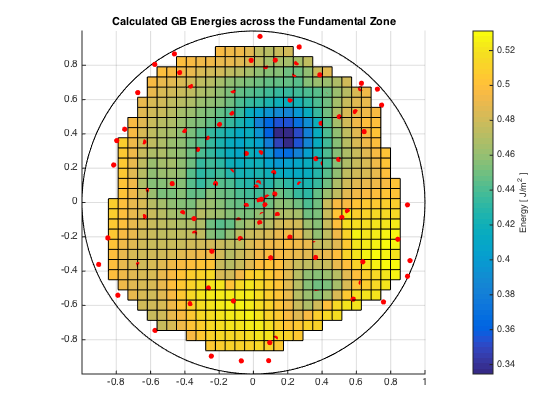Jonathan Priedeman and Eric Homer, Mechanical Engineering
The principal purpose of materials science is to investigate the relationships between microstructure, processing, properties and performance of materials to develop enhanced materials for engineering applications. Maximizing the capabilities of a given material requires control of the microstructure: the small-scale arrangement of atoms that comprise the material. Commonly in engineering metals, the atoms will arrange themselves into crystal lattices that differ from one another only in their orientation; these lattices are known as grains. The intersections between grains are grain boundaries – highly important regions of disorder that disproportionately influence macroscopic material properties due to the imperfect meshing between the two crystal lattices at the junction.
Despite centuries of metal production and use, the details of grain boundary (GB) behavior (at least microscopically) are still largely unknown. As an alternative to the inherently difficult experimental approach to GB inquiry, many researchers utilize computer simulations to explore the realm of GBs. The focus of this project is to determine, through computer simulation, the trends in GB energy corresponding to GB structure (such as GB plane orientation and GB misorientation). Understanding these relationships will elucidate, in part, the benefits to be gained by changing the microstructure in a given material.
The main difficulty in understanding GBs lies in the size of this space; however, the prevalence of symmetry means that only part of the GB plane orientation space need be considered1. This unique set of GBs is known as a fundamental zone (FZ). My advisor and I correlated external research of GB properties with FZs by translating the GBs into their appropriate FZ to better relate structure-property relationships. From this effort we published a paper2 that demonstrates both the importance of the GB plane on the properties of a GB and strong, previously unidentified structure-property trends that emerge from use of fundamental zones (FZs) as a representation medium. The publication effort consumed a significant portion of the time allocated to the current project, but served to establish an important pillar in exploration of trends between structure and energy in GBs.
The principal aim of this ORCA project is to understand the structure-energy trends of the GB space, which requires identification of the minimum energy for each GB studied. Determination of the minimum energy for a GB is a multistep process: 1) generation of a number of possible configurations for each GB (through atomic-scale variations), 2) calculation of the energy for each configuration using LAMMPS, and 3) 1 S. Patala and C. A. Schuh, Philosophical Magazine 5 (2013) p. 524. 2 E. R. Homer, S. Patala and J. Priedeman, Scientific Reports 5, 15476 (2015). selection of the minimum energy from the calculated energies of the configuration set. The number of configurations for a single GB commonly number in the tens of thousands, so I have focused on software development to facilitate these computations on the university supercomputer. Put simply, my code can submit a group of GBs for calculation as well as compile together the calculated energies and either 1) re-simulate any missing configurations or 2) return to the user the minimum energy and the associated configuration(s).
Armed with minimum energy values, the team generates plots of minimum energy across FZs. Figure 1 is a sample plot of calculated GB energy across an FZ: to illustrate the relative energies across the two-dimensional FZ, the figure depicts the interpolated surface between the energies, as viewed from above. The important discovery is the presence of energy cusps in many plots – the blue region of Figure 1. Such cusps have been observed before, but their relationship to the structure of the GB has not been explained; the team will investigate the presence of these cusps and their location in the FZs across a variety of GB misorientations. To link this research with the efforts of others, the team used an energy interpolation function to predict the energy values of the same GBs used to plot Figure 1. These data are found in Figure 2, but using the same relative scale as Figure 1. A comparison indicates that the interpolation function predicts the relative value of the GB energy well, but does not accurately reflect the variation in GB energy across the GB plane space. As the research continues to gather data, it is possible that a revised energy interpolation function be proposed.
The project to investigate GBs is ongoing. Important progress has been gained; specifically, these include integrating representation tools (FZs) into the analysis process and developing software to quickly determine the minimum energy of GB. Additional efforts have focused on how GBs in certain FZs migrate and how their migration mechanisms influence their behavior. Going forward, we plan to gain sufficient data to understand how GB energy varies across the full 5D space and provide interpolation functions for others to use. Ultimately, these advancements will enable stronger, more ductile, and more corrosion resistant materials to be created. It starts with a fundamental understanding of the GB unit influencing these properties.

Figure 1: Calculated GB Energies across the Fundamental Zone. Note the energy cusp represented as the dark blue region.

Figure 2: Interpolated GB Energies across the Fundamental Zone, using energy interpolation function. Note the relative lack of variation compared to Figure 1.
1S. Patala and C. A. Schuh, Philosophical Magazine 5 (2013) p.524.
2E.R. Homer, S. Patala and J. Priedeman, Scientific Reports 5, 15476 (2015).
